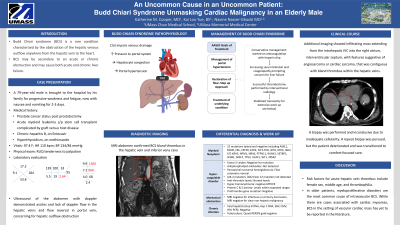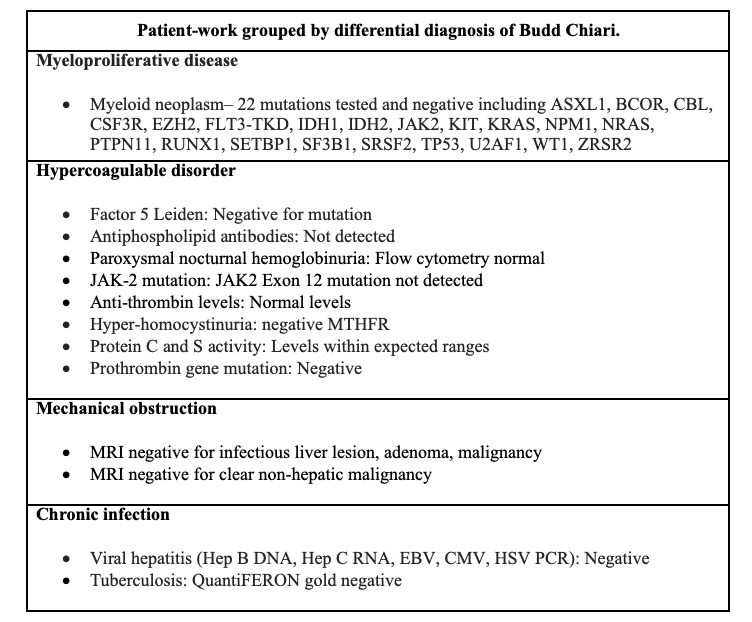Tuesday Poster Session
Category: Liver
P4842 - An Uncommon Cause in an Uncommon Patient: Budd Chiari Syndrome Unmasking Cardiac Malignancy in an Elderly Male
Tuesday, October 29, 2024
10:30 AM - 4:00 PM ET
Location: Exhibit Hall E

Has Audio

Kai-Lou Yue, BS
University of Massachusetts Chan Medical School
Worcester, MA
Presenting Author(s)
Katherine Cooper, MD1, Kai-Lou Yue, BS1, Navine Nasser-Ghodsi, MD2
1University of Massachusetts Chan Medical School, Worcester, MA; 2UMass Chan Medical School & UMass Memorial Health Care, Worcester, MA
Introduction: Budd Chiari syndrome (BCS) is a rare condition characterized by the obstruction of the hepatic vein. BCS may be secondary to an acute or chronic obstruction and may cause both acute and chronic liver failure.
Case Description/Methods: A 79-year-old male with medical history including prostate cancer status post (s/p) prostatectomy, acute myeloid leukemia s/p allogenic stem cell transplant complicated by graft versus host disease, and chronic hepatitis B presented to the hospital due to weakness and fatigue noticed by family. The patient had no acute complaints but on physical exam endorsed right upper quadrant abdominal tenderness. Pertinent laboratory evaluation included total bilirubin of 1.8 mg/dL, AST 1565 U/L, ALT 906 U/L. Ultrasound of the abdomen with doppler demonstrated ascites and lack of doppler flow in the hepatic veins and flow reversal in portal vein, concerning for hepatic outflow obstruction. An MRI abdomen confirmed a diagnosis of Budd Chiari Syndrome (BCS) with bland thrombus in the hepatic vein and inferior vena cava (IVC). Conservative management with heparin drip was initiated, however serum bilirubin continued to uptrend and the patient developed hepatic encephalopathy and coagulopathy, consistent with acute liver failure. He proceeded to successful thrombectomy with interventional radiology. In the interim, extensive work up for precipitating factors was performed (Table 1). Further imaging showed enhancing infiltrating mass extending from the intrahepatic IVC into the right atrium, interventricular septum and to a lesser extent the left atrium that was contiguous with bland thrombus within the hepatic veins. While patient's age raised concern for metastatic lesion, the mass had features suggestive of angiosarcoma or cardiac sarcoma, and no alternate primary source had been identified. A cardiac biopsy was performed and was inconclusive. The patient’s clinical status declined pending results of a repeat biopsy, and he was transitioned to comfort care.
Discussion: Risk factors for acute hepatic vein thrombus include female sex, middle age, and thrombophilia. In older patients, myeloproliferative disorders are the most common cause of intravascular BCS. While there are cases associated with cardiac myxomas, BCS in the setting of vascular cardiac mass has yet to be reported in the literature.

Disclosures:
Katherine Cooper, MD1, Kai-Lou Yue, BS1, Navine Nasser-Ghodsi, MD2. P4842 - An Uncommon Cause in an Uncommon Patient: Budd Chiari Syndrome Unmasking Cardiac Malignancy in an Elderly Male, ACG 2024 Annual Scientific Meeting Abstracts. Philadelphia, PA: American College of Gastroenterology.
1University of Massachusetts Chan Medical School, Worcester, MA; 2UMass Chan Medical School & UMass Memorial Health Care, Worcester, MA
Introduction: Budd Chiari syndrome (BCS) is a rare condition characterized by the obstruction of the hepatic vein. BCS may be secondary to an acute or chronic obstruction and may cause both acute and chronic liver failure.
Case Description/Methods: A 79-year-old male with medical history including prostate cancer status post (s/p) prostatectomy, acute myeloid leukemia s/p allogenic stem cell transplant complicated by graft versus host disease, and chronic hepatitis B presented to the hospital due to weakness and fatigue noticed by family. The patient had no acute complaints but on physical exam endorsed right upper quadrant abdominal tenderness. Pertinent laboratory evaluation included total bilirubin of 1.8 mg/dL, AST 1565 U/L, ALT 906 U/L. Ultrasound of the abdomen with doppler demonstrated ascites and lack of doppler flow in the hepatic veins and flow reversal in portal vein, concerning for hepatic outflow obstruction. An MRI abdomen confirmed a diagnosis of Budd Chiari Syndrome (BCS) with bland thrombus in the hepatic vein and inferior vena cava (IVC). Conservative management with heparin drip was initiated, however serum bilirubin continued to uptrend and the patient developed hepatic encephalopathy and coagulopathy, consistent with acute liver failure. He proceeded to successful thrombectomy with interventional radiology. In the interim, extensive work up for precipitating factors was performed (Table 1). Further imaging showed enhancing infiltrating mass extending from the intrahepatic IVC into the right atrium, interventricular septum and to a lesser extent the left atrium that was contiguous with bland thrombus within the hepatic veins. While patient's age raised concern for metastatic lesion, the mass had features suggestive of angiosarcoma or cardiac sarcoma, and no alternate primary source had been identified. A cardiac biopsy was performed and was inconclusive. The patient’s clinical status declined pending results of a repeat biopsy, and he was transitioned to comfort care.
Discussion: Risk factors for acute hepatic vein thrombus include female sex, middle age, and thrombophilia. In older patients, myeloproliferative disorders are the most common cause of intravascular BCS. While there are cases associated with cardiac myxomas, BCS in the setting of vascular cardiac mass has yet to be reported in the literature.

Figure: Patient-work grouped by differential diagnosis of Budd Chiari Syndrome.
Disclosures:
Katherine Cooper indicated no relevant financial relationships.
Kai-Lou Yue indicated no relevant financial relationships.
Navine Nasser-Ghodsi: Boston Scientific – Consultant.
Katherine Cooper, MD1, Kai-Lou Yue, BS1, Navine Nasser-Ghodsi, MD2. P4842 - An Uncommon Cause in an Uncommon Patient: Budd Chiari Syndrome Unmasking Cardiac Malignancy in an Elderly Male, ACG 2024 Annual Scientific Meeting Abstracts. Philadelphia, PA: American College of Gastroenterology.
